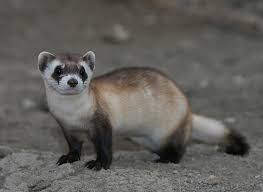
Black-footed Ferret
Conditions of detention
Black-Footed Ferrets are wild animals that thrive in prairie ecosystems. They live in burrows, primarily those made by prairie dogs, which provide them with shelter and protection from predators. Their habitat requires large expanses of open grassland with healthy prairie dog populations.
Useful Fact: Black-Footed Ferrets are nocturnal and spend most of their time underground in prairie dog burrows, coming out at night to hunt and explore.
Nutrition and diet
The diet of Black-Footed Ferrets is highly specialized, with prairie dogs making up more than 90% of their diet. They are obligate carnivores and rely heavily on hunting these rodents for survival. In captivity, Black-Footed Ferrets are fed a diet that mimics their natural intake, often consisting of rodents supplemented with vitamins and minerals.
Useful Fact: A single Black-Footed Ferret can eat up to 100 prairie dogs in a year, showcasing their dependence on this specific prey for survival.
Health
In the wild, Black-Footed Ferrets face threats from disease, predation, and habitat loss. Canine distemper and sylvatic plague are significant threats that have decimated ferret populations in the past. In captivity, they are carefully monitored for these diseases, and vaccination programs are in place to protect them.
Useful Fact: Conservationists use vaccines to protect Black-Footed Ferrets from diseases like sylvatic plague, which can wipe out entire populations if not controlled.
Grooming and care
As wild animals, Black-Footed Ferrets do not require grooming in the traditional sense. In captivity, they are cared for by wildlife professionals who monitor their health and ensure their living conditions replicate the wild as closely as possible.
Useful Fact: In captivity, Black-Footed Ferrets are provided with enrichment activities that mimic their natural behavior, such as digging and hunting, to maintain their physical and mental health.
Education and training
Black-Footed Ferrets are not typically trained as domesticated ferrets might be. However, in captivity, they undergo conditioning to facilitate their care, such as being accustomed to handling for medical checks. Training also helps prepare them for reintroduction into the wild, where they must be able to hunt and survive independently.
Useful Fact: When preparing for reintroduction into the wild, captive-bred Black-Footed Ferrets are sometimes placed in semi-wild environments to develop their hunting skills.
Toys and entertainment
In captivity, Black-Footed Ferrets are provided with environmental enrichment to stimulate their natural behaviors. This includes objects they can dig in, tunnels to explore, and opportunities to hunt live prey, which helps keep them mentally and physically fit.
Useful Fact: Providing Black-Footed Ferrets with live prey in captivity helps maintain their hunting instincts, which are crucial for survival once reintroduced into the wild.
Safety
Safety for Black-Footed Ferrets in captivity involves protecting them from disease, stress, and ensuring they have an environment that meets their complex needs. In the wild, their safety depends on the availability of prey, habitat preservation, and protection from predators.
Useful Fact: Conservationists monitor Black-Footed Ferret populations closely, using radio collars and other technology to track their movements and ensure their safety in the wild.
Accessories
Black-Footed Ferrets do not require accessories like domestic ferrets, but in captivity, they need specialized enclosures that mimic their natural burrow systems. These enclosures are designed to allow digging, climbing, and other natural behaviors.
Useful Fact: Enclosures for captive Black-Footed Ferrets are often equipped with tunnels and burrows to replicate their natural habitat and keep them engaged.
Socialization
Black-Footed Ferrets are solitary animals, typically coming together only during the breeding season. In captivity, they are often housed alone or in pairs, depending on the breeding program’s needs. Socialization with humans is minimal, focusing on necessary handling for medical care.
Useful Fact: During the breeding season, male Black-Footed Ferrets may become more aggressive, which is natural behavior as they compete for mates.
Travel and Transportation
When Black-Footed Ferrets need to be moved, such as for reintroduction into the wild or transfer between breeding facilities, they are transported in secure, well-ventilated carriers designed to minimize stress. The process is carefully managed to ensure their safety.
Useful Fact: Transportation of Black-Footed Ferrets is a delicate process, often involving sedation or careful handling to reduce stress during travel.
Behavior and psychology
Black-Footed Ferrets are nocturnal, solitary, and highly territorial. They are skilled hunters with keen senses, particularly for detecting prairie dogs. Their behavior is driven by their need to hunt and maintain a territory, making them less social and more independent compared to domesticated ferrets.
Useful Fact: Black-Footed Ferrets are known for their “war dance” after a successful hunt, a behavior also seen in domesticated ferrets, which is a sign of excitement and triumph.
Legal aspects
Black-Footed Ferrets are an endangered species, and their conservation is tightly regulated. It is illegal to own them as pets. Their management falls under the jurisdiction of wildlife agencies, and breeding programs are run by accredited facilities as part of international conservation efforts.
Useful Fact: The Black-Footed Ferret recovery program is one of the most successful wildlife conservation efforts in the United States, with several breeding and reintroduction programs helping to slowly rebuild their population.


